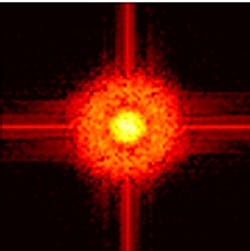Spectroscopy images Landau levels for the first time
Physicists have directly imaged Landau levels for the first time since they were theoretically conceived of by Nobel prize winner Lev Landau.
In 1930, Landau proposed that charged particles such as electrons in magnetic fields could only occupy orbits with discrete energy values, which he called Landau levels. The number of electrons in each level is directly proportional to the strength of the applied magnetic field.
Now, using scanning tunneling spectroscopy -- an extension of scanning tunneling microscopy that provides information about the density of electrons in a sample as a function of their energy -- scientists at institutions including Warwick University (Coventry, UK) and Tohoku University (Sendai, Japan) have revealed the internal ring-like structure of these Landau levels at the surface of a semiconductor.
The images clearly show that Landau was right when he predicted that the electrons would take the form of concentric rings, the number of which increase according to their energy level.
"This is an exciting step for us. We are really seeing for the first time individual quantum mechanical wave functions of electrons in real materials," says Professor Rudolf Roemer of the Department of Physics at Warwick University.
The research was published in the journal Physical Review Letters in a paper entitled "Robust Nodal Structure of Landau Level Wave Functions Revealed by Fourier Transform Scanning Tunneling Spectroscopy". Details can be found here.
Recent articles on spectroscopy that you might also find of interest.
1. Spectroscopy aids brain tumor detection
UK researchers have shown that infrared and Raman spectroscopy - coupled with statistical analysis - can be used to differentiate between normal brain tissue and different tumor types.
2. Near infrared spectroscopy determines the hardness of corn grains
A near infrared (NIR) spectroscopy imaging technique can determine the hardness of corn grains without destroying them. The new technique could offer food processors savings in time and money compared to other methods for determining grain hardness.
3. Spectroscopy sniffs out fake spirits
Researchers at St. Andrews University (St. Andrews, Fife, Scotland) are using a microfluidic device coupled with a laser-based near-infrared (NIR) spectroscopy system to characterize whiskies and identify fakes.
4. Spectroscopy detects explosives over long distances
Researchers at the Vienna University of Technology (Vienna, Austria) have developed a system to detect chemicals inside a container over a distance of more than a hundred meters.
5. Spectroscopy aids in characterizing skin cancers
A joint US-Dutch team under the direction of Anita Mahadevan-Jansen from Vanderbilt University (Nashville, TN, USA) has developed a noninvasive probe capable of both morphological and biochemical characterization of skin cancers.
-- Dave Wilson, Senior Editor, Vision Systems Design
